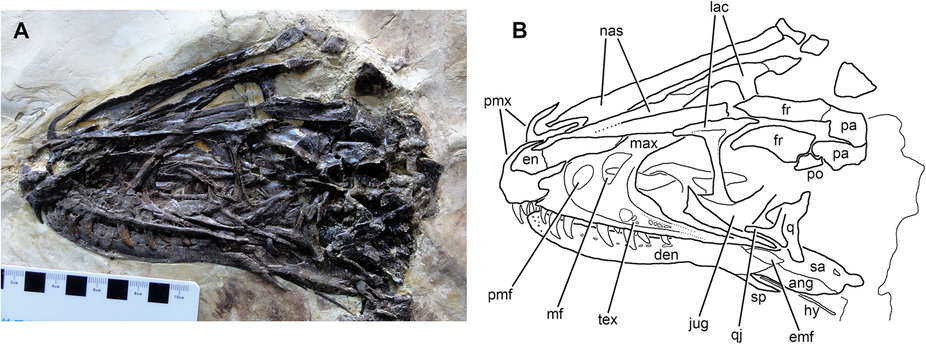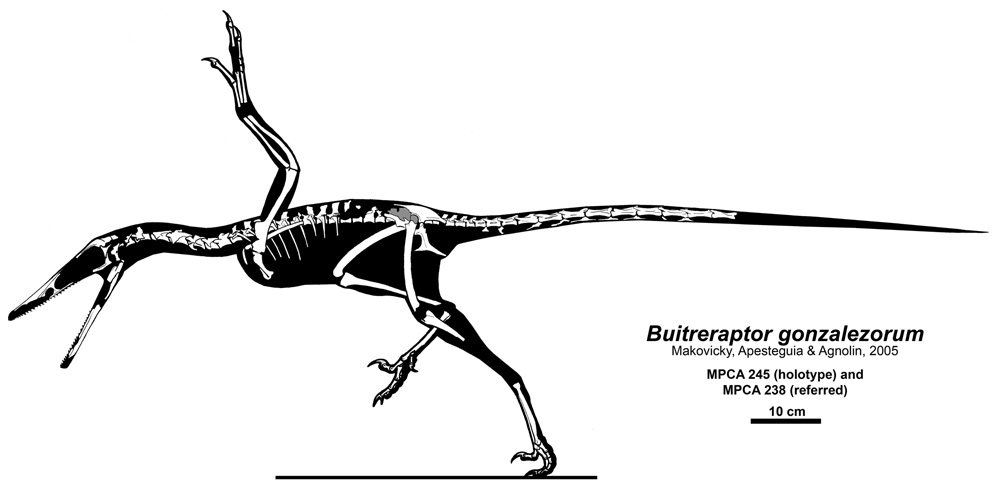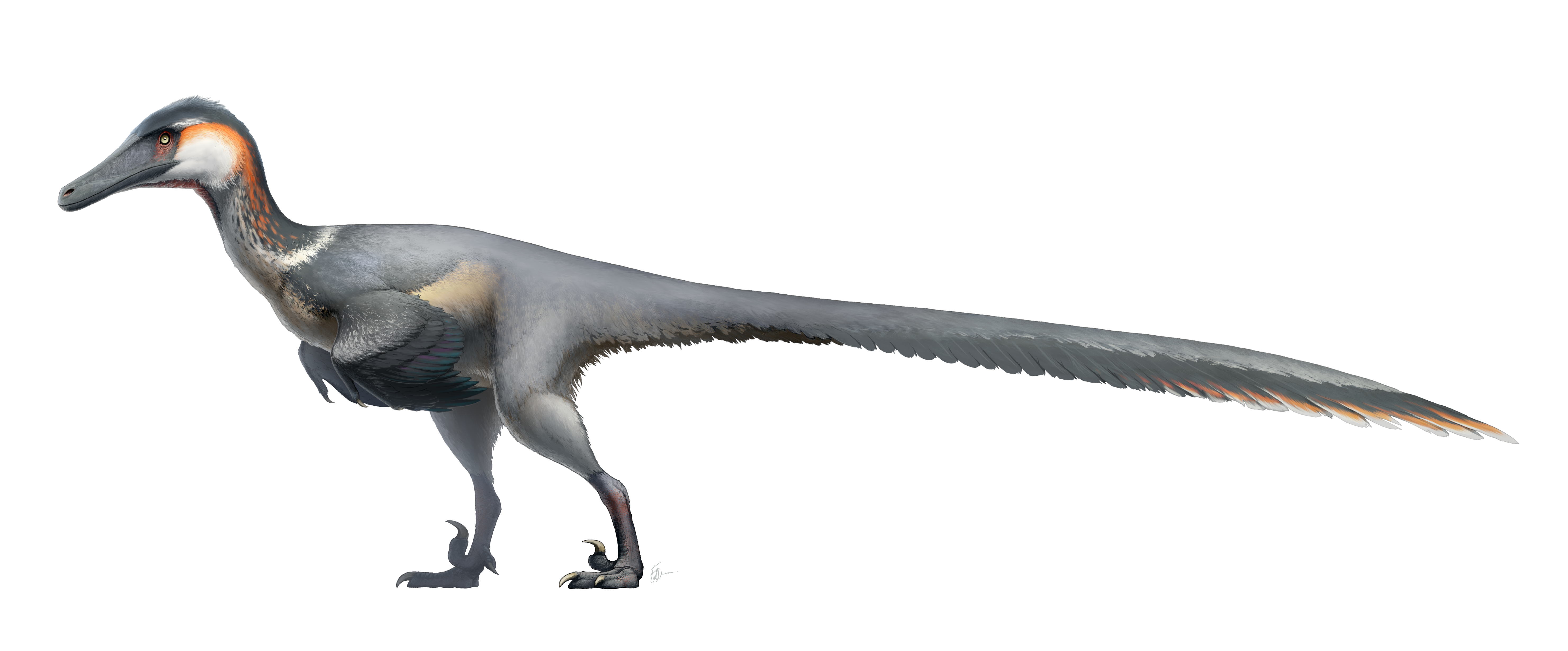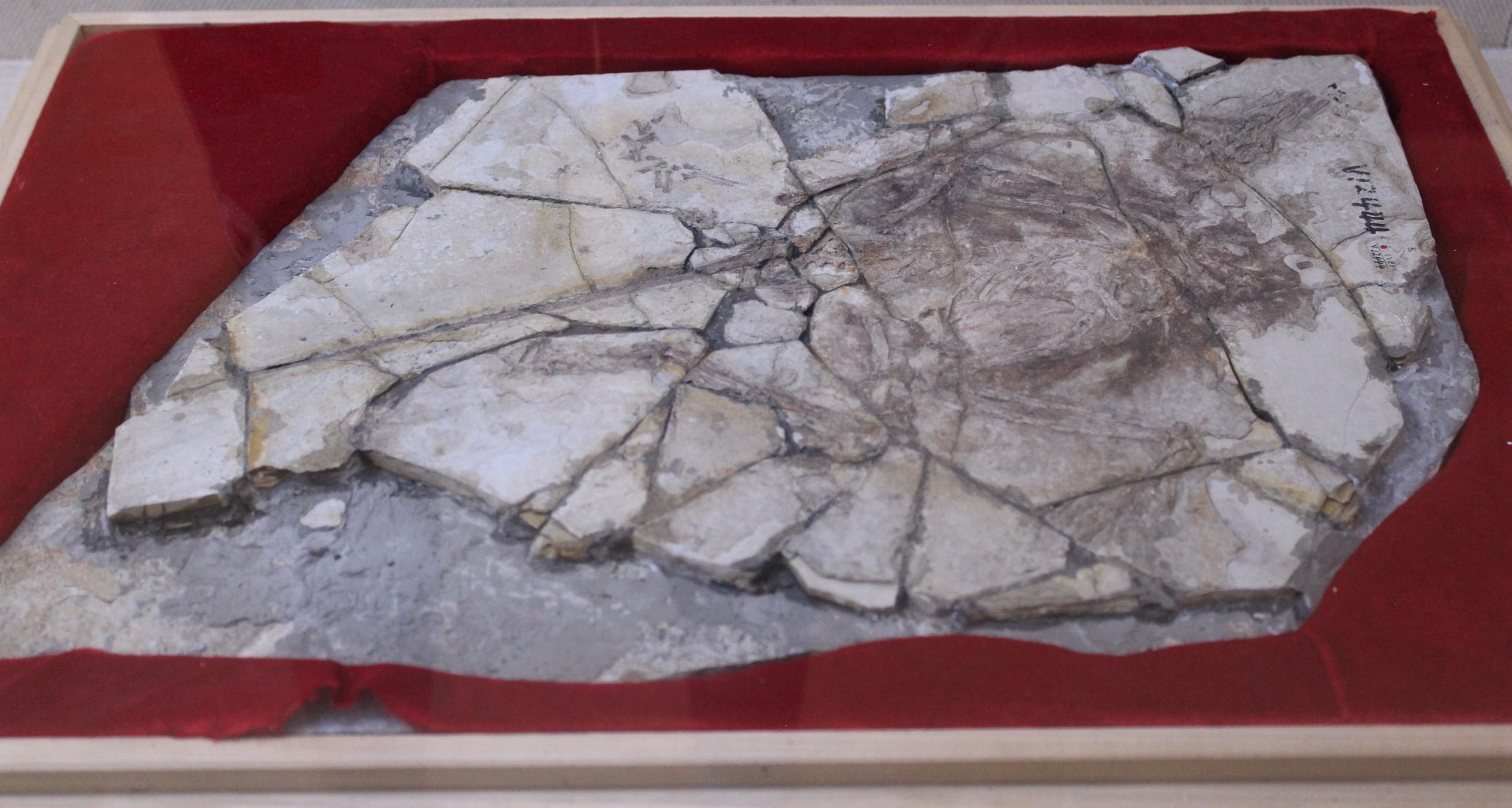|
Dromaeosaurids
Dromaeosauridae () is a family of feathered theropod dinosaurs. They were generally small to medium-sized feathered carnivores that flourished in the Cretaceous Period. The name Dromaeosauridae means 'running lizards', from Greek ('), meaning 'runner', and ('), meaning 'lizard'. In informal usage, they are often called raptors (after ''Velociraptor''), a term popularized by the film ''Jurassic Park''; a few types include the term "raptor" directly in their name and have come to emphasize their bird-like appearance and speculated bird-like behavior. Dromaeosaurid fossils have been found across the globe in North America, Europe, Africa, Asia, South America and Antarctica, with some fossils giving credence to the possibility that they inhabited Australia as well. They first appeared in the mid-Jurassic Period (late Bathonian stage, about 167 million years ago) and survived until the end of the Cretaceous (Maastrichtian stage, 66 ma), existing until the Cretaceous–Paleogene ext ... [...More Info...] [...Related Items...] OR: [Wikipedia] [Google] [Baidu] |
Zhenyuanlong
''Zhenyuanlong'' (meaning ''"Zhenyuan's dragon"'', from Chinese Pinyin 龙/ 龍 lóng ''"dragon"'') is a genus of dromaeosaurid dinosaur from the Yixian Formation of Liaoning, China. It lived during the Aptian age of the early Cretaceous period, approximately 125 million years ago. It is known from a single specimen belonging to the species ''Zhenyuanlong suni'' (Chinese: 孫氏振元龍). This type specimen preserved a nearly complete skeleton that contains traces of feathers, including long tail feathers and large wings. In addition to further complicating diversity of Liaoning dromaeosaurids, this specimen provides the first evidence of well-developed pennaceous feathers in a large, non-flying dromaeosaur, raising the question of what function such wings would serve. Discovery The specimen was found by a local farmer near Sihedang in Jianchang, Liaoning Province and was later secured for study at the Jinzhou Paleontological Museum by Zhenyuan Sun, a representative of the m ... [...More Info...] [...Related Items...] OR: [Wikipedia] [Google] [Baidu] |
Velociraptor
''Velociraptor'' (; ) is a genus of small dromaeosaurid dinosaur that lived in Asia during the Late Cretaceous epoch, about 75 million to 71 million years ago. Two species are currently recognized, although others have been assigned in the past. The type species is ''V. mongoliensis''; fossils of this species have been discovered in the Djadochta Formation, Mongolia. A second species, ''V. osmolskae'', was named in 2008 for skull material from the Bayan Mandahu Formation, China. Smaller than other dromaeosaurids like ''Deinonychus'' and ''Achillobator'', ''Velociraptor'' was about long with a body mass between . It nevertheless shared many of the same anatomical features. It was a bipedal, feathered carnivore with a long tail and an enlarged sickle-shaped claw on each hindfoot, which is thought to have been used to tackle and restrain prey. ''Velociraptor'' can be distinguished from other dromaeosaurids by its long and low skull, with an upturned snout. ''Velociraptor'' (com ... [...More Info...] [...Related Items...] OR: [Wikipedia] [Google] [Baidu] |
Zhenyuanlong
''Zhenyuanlong'' (meaning ''"Zhenyuan's dragon"'', from Chinese Pinyin 龙/ 龍 lóng ''"dragon"'') is a genus of dromaeosaurid dinosaur from the Yixian Formation of Liaoning, China. It lived during the Aptian age of the early Cretaceous period, approximately 125 million years ago. It is known from a single specimen belonging to the species ''Zhenyuanlong suni'' (Chinese: 孫氏振元龍). This type specimen preserved a nearly complete skeleton that contains traces of feathers, including long tail feathers and large wings. In addition to further complicating diversity of Liaoning dromaeosaurids, this specimen provides the first evidence of well-developed pennaceous feathers in a large, non-flying dromaeosaur, raising the question of what function such wings would serve. Discovery The specimen was found by a local farmer near Sihedang in Jianchang, Liaoning Province and was later secured for study at the Jinzhou Paleontological Museum by Zhenyuan Sun, a representative of the m ... [...More Info...] [...Related Items...] OR: [Wikipedia] [Google] [Baidu] |
Buitreraptor
''Buitreraptor'' (meaning "La Buitrera seizer") is a genus of dromaeosaurid dinosaurs that lived during the Late Cretaceous of Argentina at the Candeleros Formation. ''Buitreraptor'' was described in 2005 and the type species is ''Buitreraptor gonzalezorum''. It was rooster-sized and had a very elongated head with many small teeth. History of discovery Four specimens of ''Buitreraptor'' were found in 2004 in sandstone in Patagonia, Argentina during an excavation led by Sebastián Apesteguia, researcher of CONICET at the Fundacion Felix de Azara - Maimonides University, and Peter Makovicky, curator of dinosaurs at the Field Museum in Chicago. ''Buitreraptor'' is from the early Late Cretaceous Candeleros Formation, dating to the Cenomanian-Turonian ages approximately 98 to 97 million years ago, when South America was an isolated continent like Australia today. It was uncovered in a famous fossil site named ''La Buitrera'', the "vulture roost". Although dinosaurs are rare in thi ... [...More Info...] [...Related Items...] OR: [Wikipedia] [Google] [Baidu] |
Deinonychus
''Deinonychus'' ( ; ) is a genus of dromaeosaurid theropod dinosaur with one described species, ''Deinonychus antirrhopus''. This species, which could grow up to long, lived during the early Cretaceous Period, about 115–108 million years ago (from the mid-Aptian to early Albian stages). Fossils have been recovered from the U.S. states of Montana, Utah, Wyoming, and Oklahoma, in rocks of the Cloverly Formation, Cedar Mountain Formation and Antlers Formation, though teeth that may belong to ''Deinonychus'' have been found much farther east in Maryland. Paleontologist John Ostrom's study of ''Deinonychus'' in the late 1960s revolutionized the way scientists thought about dinosaurs, leading to the " dinosaur renaissance" and igniting the debate on whether dinosaurs were warm-blooded or cold-blooded. Before this, the popular conception of dinosaurs had been one of plodding, reptilian giants. Ostrom noted the small body, sleek, horizontal posture, ratite-like spine, and esp ... [...More Info...] [...Related Items...] OR: [Wikipedia] [Google] [Baidu] |
Dinosaur
Dinosaurs are a diverse group of reptiles of the clade Dinosauria. They first appeared during the Triassic period, between 243 and 233.23 million years ago (mya), although the exact origin and timing of the evolution of dinosaurs is the subject of active research. They became the dominant terrestrial vertebrates after the Triassic–Jurassic extinction event 201.3 mya; their dominance continued throughout the Jurassic and Cretaceous periods. The fossil record shows that birds are feathered dinosaurs, having evolved from earlier theropods during the Late Jurassic epoch, and are the only dinosaur lineage known to have survived the Cretaceous–Paleogene extinction event approximately 66 mya. Dinosaurs can therefore be divided into avian dinosaurs—birds—and the extinct non-avian dinosaurs, which are all dinosaurs other than birds. Dinosaurs are varied from taxonomic, morphological and ecological standpoints. Birds, at over 10,700 living species, are among ... [...More Info...] [...Related Items...] OR: [Wikipedia] [Google] [Baidu] |
Unenlagiinae
Unenlagiinae is a subfamily of long-snouted Paraves, paravian theropods. They are traditionally considered to be members of Dromaeosauridae, though some authors place them into their own family, Unenlagiidae, alongside the subfamily Halszkaraptorinae. Unenlagiines are known from South America, with possible unenlagiines being known from North America, Madagascar, Europe, and even Australia. Description Most unenlagiines have been discovered in Argentina. The largest was ''Austroraptor'', which measured up to 5–6 m (16.4–19.7 ft) in length, making it also one of the largest dromaeosaurids. The subfamily is distinguished from other dromaeosaurids by a tail stiffened by lengthy chevrons and superior processes, a reduced second pedal ungual, a posteriorly oriented pubis and very elongated snouts. Unenlagiines also had elongated, slender hindlimbs with a subarctometatarsalian metatarsus, which is characterized by the pinched metatarsal III at the upper end. Their distinct ... [...More Info...] [...Related Items...] OR: [Wikipedia] [Google] [Baidu] |
Pyroraptor
''Pyroraptor'' (meaning "fire thief") is an extinct genus of paravian dinosaur, probably a dromaeosaurid or unenlagiid (considering that unenlagiids are a separate family), from the Late Cretaceous Ibero-Armorican island, of what is now southern France and northern Spain. It lived during the late Campanian and early Maastrichtian stages, approximately 70.6 million years ago. It is known from a single partial specimen that was found in Provence in 1992, after a forest fire. The animal was named ''Pyroraptor olympius'' by Allain and Taquet in 2000. Discovery and naming Naming and Material The first remains of ''Pyroraptor olympius'', or P. olympius, were discovered in southeastern France, at the La Boucharde locality of the Arc Basin in Provence. It was described and named by French paleontologists Ronan Allain and Philippe Taquet in 2000, the type species and so far the only species is ''Pyroraptor olympius''. The genus name is Greek for "Fire thief", due to its remains ... [...More Info...] [...Related Items...] OR: [Wikipedia] [Google] [Baidu] |
Microraptoria
Microraptoria (Greek, μίκρος, ''mīkros'': "small"; Latin, ''raptor'': "one who seizes") is a clade of basal dromaeosaurid theropod dinosaurs. The first microraptorians appeared 125 million years ago in China. Many are known for long feathers on their legs and may have been semiarboreal powered fliers, some of which were even capable of launching from the ground.. Most microraptorians were relatively small; adult specimens of ''Microraptor'' range between ) and weigh up to , making them some of the smallest known nonavialan dinosaurs.Holtz, Thomas R. Jr. (2011) ''Dinosaurs: The Most Complete, Up-to-Date Encyclopedia for Dinosaur Lovers of All Ages,'Winter 2010 Appendix./ref> Description Microraptorians were a group of basal dromaeosaurids (popularly known as "raptors") with slender proportions and long limbs. With the exception of ''Hesperonychus'' from the late Cretaceous of North America, all microraptorians have been found in the Yixian and Jifuotang Formations of Liao ... [...More Info...] [...Related Items...] OR: [Wikipedia] [Google] [Baidu] |
Microraptor
''Microraptor'' (Greek, μικρός, ''mīkros'': "small"; Latin, ''raptor'': "one who seizes") is a genus of small, four-winged dromaeosaurid dinosaurs. Numerous well-preserved fossil specimens have been recovered from Liaoning, China. They date from the early Cretaceous Jiufotang Formation (Aptian stage), 125 to 120 million years ago. Three species have been named (''M. zhaoianus'', ''M. gui'', and ''M. hanqingi''), though further study has suggested that all of them represent variation in a single species, which is properly called ''M. zhaoianus''. ''Cryptovolans'', initially described as another four-winged dinosaur, is usually considered to be a synonym of ''Microraptor''. Like ''Archaeopteryx'', well-preserved fossils of ''Microraptor'' provide important evidence about the evolutionary relationship between birds and earlier dinosaurs. ''Microraptor'' had long pennaceous feathers that formed aerodynamic surfaces on the arms and tail but also on the legs. This led paleon ... [...More Info...] [...Related Items...] OR: [Wikipedia] [Google] [Baidu] |
Theropoda
Theropoda (; ), whose members are known as theropods, is a dinosaur clade that is characterized by hollow bones and three toes and claws on each limb. Theropods are generally classed as a group of saurischian dinosaurs. They were ancestrally carnivorous, although a number of theropod groups evolved to become herbivores and omnivores. Theropods first appeared during the Carnian age of the late Triassic Period (geology), period 231.4 million years ago (Year#SI prefix multipliers, Ma) and included all the large terrestrial carnivores from the Early Jurassic until at least the close of the Cretaceous, about 66 Ma. In the Jurassic, birds evolved from small specialized coelurosaurian theropods, and are today represented by about 10,500 living species. Biology Diet and teeth Theropods exhibit a wide range of diets, from insectivores to herbivores and carnivores. Strict carnivory has always been considered the ancestral diet for theropods as a group, and a wider variety of di ... [...More Info...] [...Related Items...] OR: [Wikipedia] [Google] [Baidu] |
Eudromaeosauria
Eudromaeosauria ("true dromaeosaurs") is a subgroup of terrestrial dromaeosaurid theropod dinosaurs. They were relatively small to medium-sized, feathered hypercarnivores (with diets consisting almost entirely of other terrestrial vertebrates) that flourished in the Cretaceous Period. Eudromaeosaur fossils are known almost exclusively from the northern hemisphere. They first appeared in the early Cretaceous Period (early Aptian stage, about 124 million years ago) and survived until the end of the Cretaceous (Maastrichtian stage, Ma). The earliest known definitive eudromaeosaur is the dromaeosaurine '' Utahraptor ostrommaysi'', from the Cedar Mountain Formation, dated to 124 million years ago. However, the earlier (143-million-year-old) fossils such as those of '' Nuthetes destructor'' and several indeterminate teeth dating to the Kimmeridgian stage may represent eudromaeosaurs. Description While other dromaeosaurids filled a variety of specialized ecological niches, mainly tho ... [...More Info...] [...Related Items...] OR: [Wikipedia] [Google] [Baidu] |










